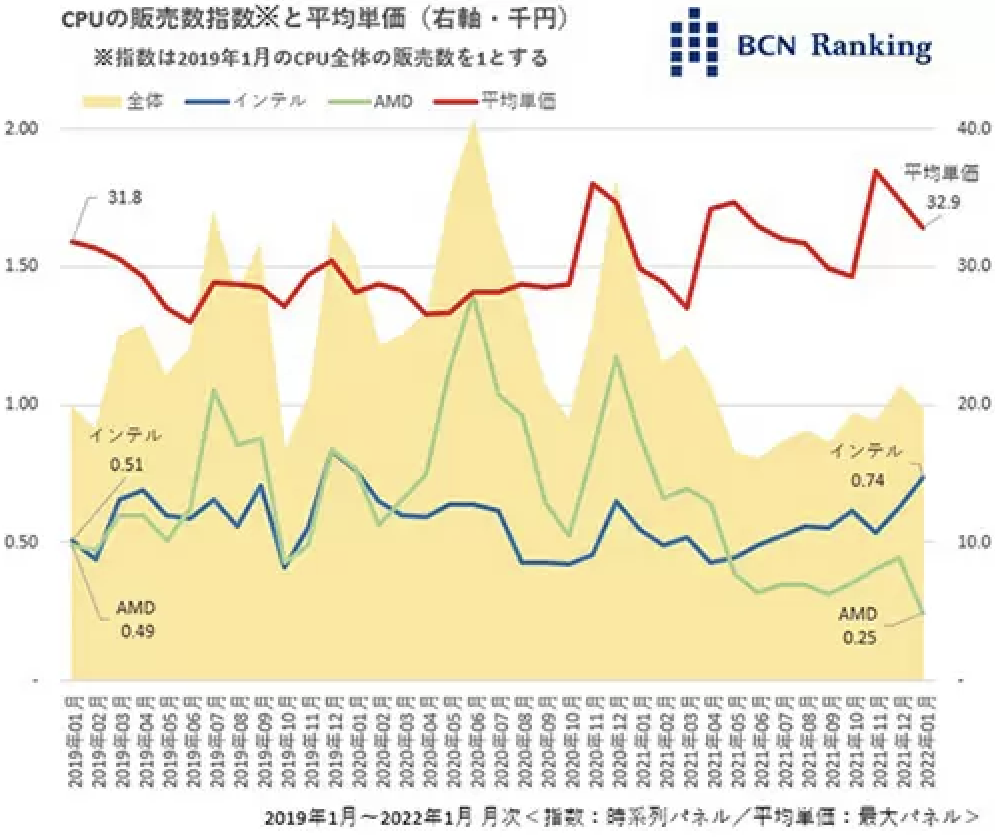AMD CPU Shipments in Japan Sink to 25% of Total, Intel Achieves 74%
AMD had a rough month in Japan this January, sinking to a three year low.
AMD's market share in Japan is in decline, ceding significant ground to Intel in recent months. According to information collated by BCN, a Japanese electronics aggregator that pulls sales volume data from retailers and e-tailers across the country, AMD-branded CPU sales hit their lowest point in three years this January, commanding only 25% of total sales volume. AMD's loss is Intel's win, as is usually the case, with the blue giant securing a 74% share of total sales for the same month.
AMD's Japanese market share (by monthly sales volume) achieved a high of around 70% in June 2020; a second peak at 68% of monthly CPU shipments occurred in December of the same year — likely bolstered by the introduction of the Ryzen 5000-series CPU family a month earlier. In either case, it seems that the most popular AMD products centered around the excellent price-to-performance ratio of the Ryzen 5 family, and products within this family accounted for almost half of AMD's sales during those peak months.

AMD's market share gains aren't only attributable to itself, however, as Intel faced severe shortages throughout 2020 due to low production yields with its 10nm manufacturing process (now rebranded to Intel 7). These wreaked havoc with Intel's roadmap, and even forced the company to backport designs to 14nm in order to meet performance and volume demands, avoiding the ill-fated (at the time) 10nm process. Intel's less competitive portfolio, higher volume of overall global market share across product categories, and AMD's then-advantage of having its production at TSMC meant that AMD products were able to fill the void left by Intel's production woes.
But of course, tides turn in the semiconductor space, and Intel has generally recovered from its manufacturing issues, ramping up volumes after the re-engineering of the 10nm process with its SuperFin technology. AMD, meanwhile, is now facing shortages with foundry partner TSMC, which serves some of the biggest wafer-consuming companies in the world alongside AMD — Apple, Qualcomm, and several other clients all battle for TSMC's limited node production capacity, which has been exacerbated by the pandemic.

One might think that AMD's market share decline means the company's CPUs have somehow become so much less desirable than Intel's. The launch of Alder Lake and the 12th Gen Core family, which put Intel back at CPU performance parity with AMD (and in our Best CPUs for Gaming picks), certainly contributed to the decline in AMD's sales. However, that's likely not the only reason, as despite the overwhelming demand and supply constraints experienced in the electronics space, AMD has consistently outpaced itself in earnings, leading the IC (Integrated Circuit) industry's growth for 2021.
AMD, like all other companies, prioritizes manufacturing (and deliveries) of products with higher ASPs (Average Sale Price) — and even then, AMD also prioritizes stocks and supplies for the markets in which its brand recognition is stronger. We may merely be looking at the effects of AMD's product and distribution priorities, but the fact remains that Intel outsold AMD three-to-one in Japan, with a significant amount of the sales volume gain spiking after Alder Lake's November 2021 launch. A month doesn't a trend make, but smoke does mostly arise wherever there's a fire.
Get Tom's Hardware's best news and in-depth reviews, straight to your inbox.

Francisco Pires is a freelance news writer for Tom's Hardware with a soft side for quantum computing.